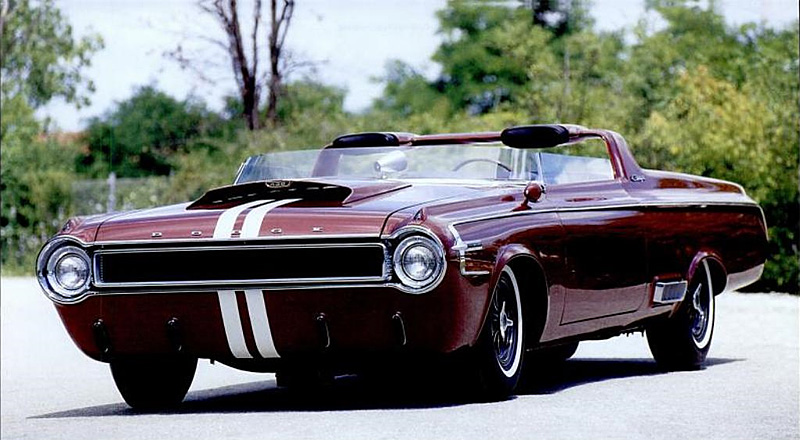1964 Dodge Charger
 1964 Dodge Charger
1964 Dodge Charger 1964 Dodge Charger
1964 Dodge ChargerLike every other manufacturer of low- and medium-priced cars in America in 1964, the "Dodge Boys" spent the year watching buyers flock to Pontiac showrooms to buy GTOs. The fact that Pontiac had hit on the idea of an affordable, completely packaged performance car sent its rivals scrambling.
Like the others, Dodge got the message loud and clear about how to market high-performance cars. Simply having the fastest cars on the road was not a surefire guarantee of sales success. A good dollop of image was going to be required, too.
Realizing that they were now in a reactive situation, Dodge product planners knew that if they couldn't be first, they had to be best, and quickly embarked on a program to bring the new breed of muscle car buyer to their camp.
They certainly had the hardware: Their drivelines were second to none. But until it could get a direct competitor for the GTO into production, the quickest way for Dodge to catapult itself squarely into the muscle car mindset was to build a show car that embodied the new era. Enter the 1964 Charger, an aggressive one-off show car that left no doubt about Dodge Division's high-performance intentions.
According to the original press release, the Charger was "inspired by the outstanding competition records set by Dodge production cars in recent years." While the Charger started life as a 119-inch-wheelbase B-body 1964 Polara, there was a lot to distinguish it from its production counterparts.
Yet it was not a "pie in the sky" concept car in the manner of the Chrysler-Ghia specials of the previous decade. Instead, it was a "sliced and diced" production car that still had a tangible connection to the cars in dealer showrooms. That fact would tip off Dodge's plans for entering the muscle car field more effectively than a nonproduction-based concept car ever could.
The Charger was intended to be more than just a static display; it was meant to actually back up the persona with a functional and very high-performance driveline. Inspired by Dodge's proud drag racing tradition, the Charger made use of several custom design cues that were popular at the time, all catering to the horsepower craze that had captured the imaginations of the Baby Boomer generation.
Up front, the standard bumper and grille were discarded, replaced with a custom blacked-out grille that featured a rectangular chrome surround and a body-colored rolled front pan with four small vertical bump strips. (This customizing treatment cost the Charger two of the four headlights normally found on factory-issue Polaras.) The stock hood used a large scoop with a "426" callout on its leading edge to suggest what might lie beneath -- though this was another bit of showmanship, as we'll see.
As in the front, the rear bumper was forsaken in favor of a rolled pan. It, too, was body colored and sported a quartet of rubber-tipped bump strips. The Charger's burgundy paint job was accented by two parallel white stripes that ran down the center of the car.
The standard windshield was removed and replaced with a cut-down racing windscreen complemented by low-rise door glass. The Charger's racy image was further accentuated with a combination roll bar and dual headrest mount located over where the rear passengers would normally sit.
The entire area was covered by sheetmetal, producing a true two-seat layout and an exceptionally long rear deck. These radical modifications worked with the lowered suspension to reduce the overall height of the car to a scant 47.75 inches.
Bodysides were set off with shaved door handles, "Charger" scripts on both sides of the roll bar, an abbreviated version of the production Polara side trim, and the unique exhaust ducts located between the doors and rear wheels. They could be made functional with the flip of a switch.
Otherwise, exhaust gases would exit through the conventional dual exhaust outlets. A body-colored "racing" mirror was mounted on the left front fender. Custom Halibrand racing wheels were shod with Goodyear Wingfoot whitewall tires.
The Charger's interior bore little resemblance to its production counterparts. It was characterized by a large center cockpit divider upholstered with leather-trimmed crash panels. Combined with the full-length console, the divider gave a definite jet-fighter feel.
A custom 8,000-rpm Stewart-Warner tachometer was mounted on the divider, which also carried the racing stripes in an unbroken line from nose to tail. The driver was treated to a deep-dish walnut steering wheel and matching shifter handle, while the passenger was provided with a walnut grab handle.
Tidak ada komentar:
Posting Komentar